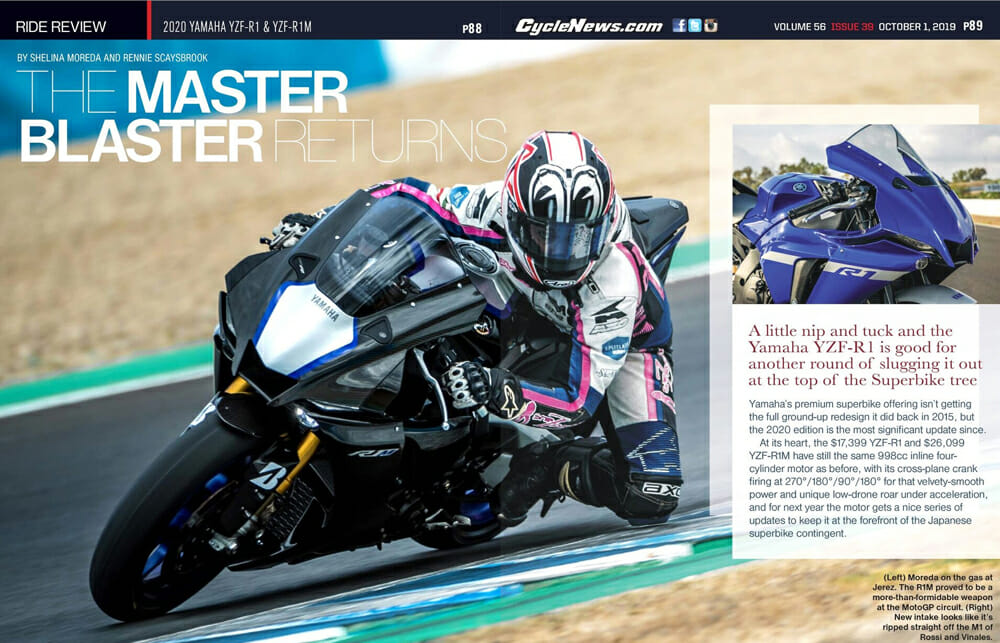Rennie Scaysbrook | October 8, 2019
A little nip and tuck and the Yamaha YZF-R1 is good for another round of slugging it out at the top of the Superbike tree.
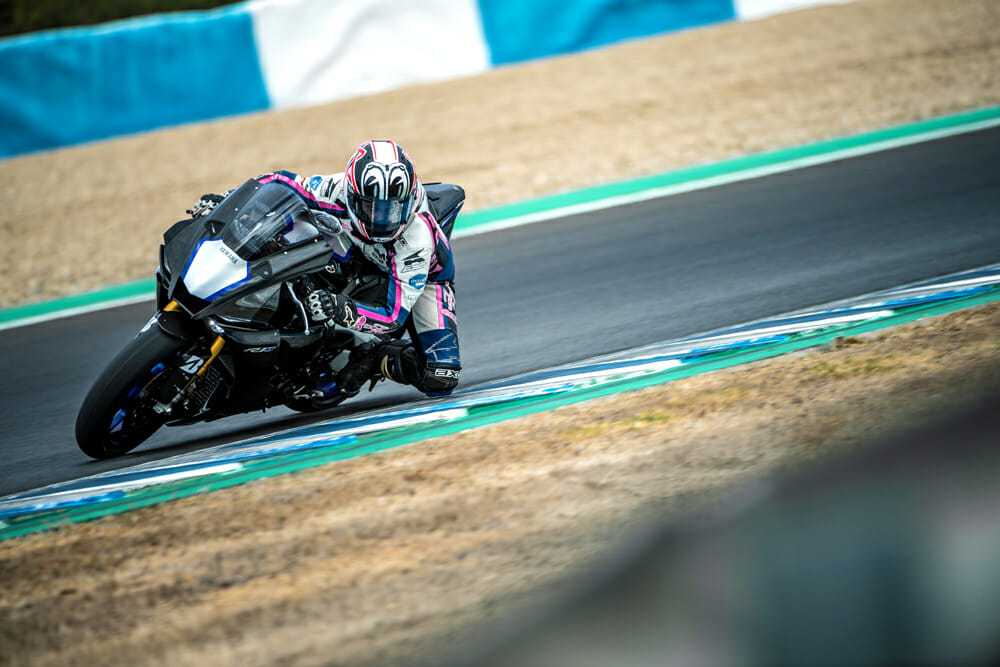 Moreda on the gas at Jerez. The R1M proved a more than formidable weapon at the MotoGP circuit.
Moreda on the gas at Jerez. The R1M proved a more than formidable weapon at the MotoGP circuit.
By Shelina Moreda and Rennie Scaysbrook
Yamaha’s premium superbike offering isn’t getting the full ground-up redesign it did back in 2015, but the 2020 edition is the most significant update since.
At its heart, the $17,399 YZF-R1 and $26,099 YZF-R1M have still the same 998cc inline four-cylinder motor its always been, with its cross-plane crank firing at 270°/180°/90°/180° for that velvety-smooth power and unique low-drone roar under acceleration, and for next year the motor gets a nice series of updates to keep it at the forefront of the Japanese superbike contingent.
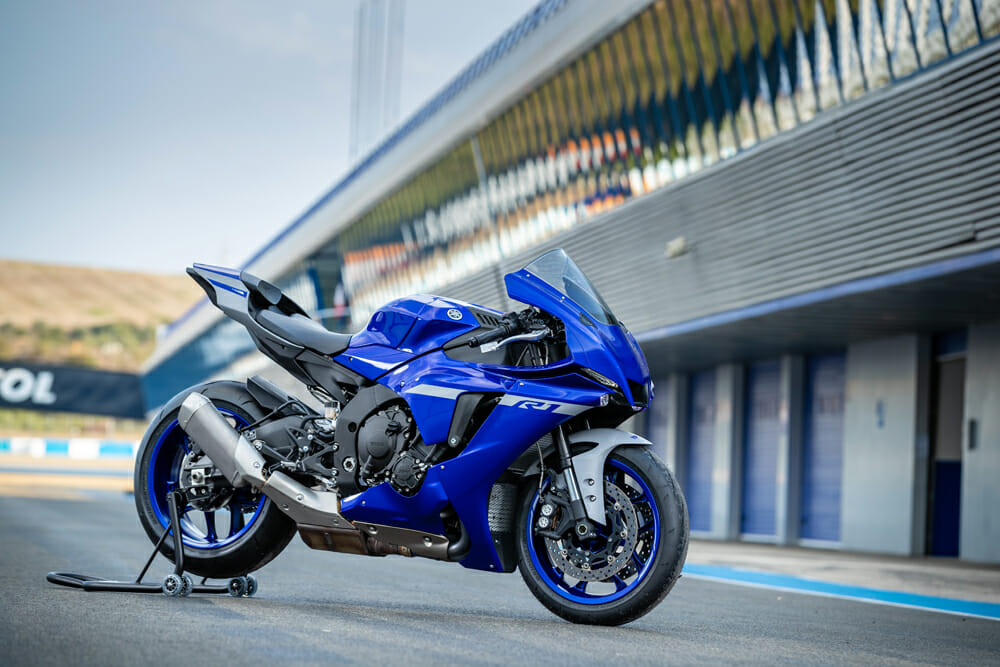 Slight styling updates including a reworked fairing differentiate the 2020 R1 from this year.
Slight styling updates including a reworked fairing differentiate the 2020 R1 from this year.
2020 Yamaha YZF-R1 and R1M Motor
At the top, the R1’s intake ports have been shortened and the intake volume reduced by 12 percent. A new 10-hole injector replaces the 12-hole one used on the 2019 R1 with the spray now angled much more steeply toward the intake valve for better atomization.
The cylinder head’s exhaust port gets larger cooling passages, sleeker rocker arms for the cams that are slighter lower in profile than in 2019 and the cams have new a new profile—although lift and overlap remain unchanged.
At the bottom, the oil pump rotor width has been reduced 2mm to 20mm, the big-end oil passage size has been reduced 0.5mm, and plain bearing journal width increased by 3mm.
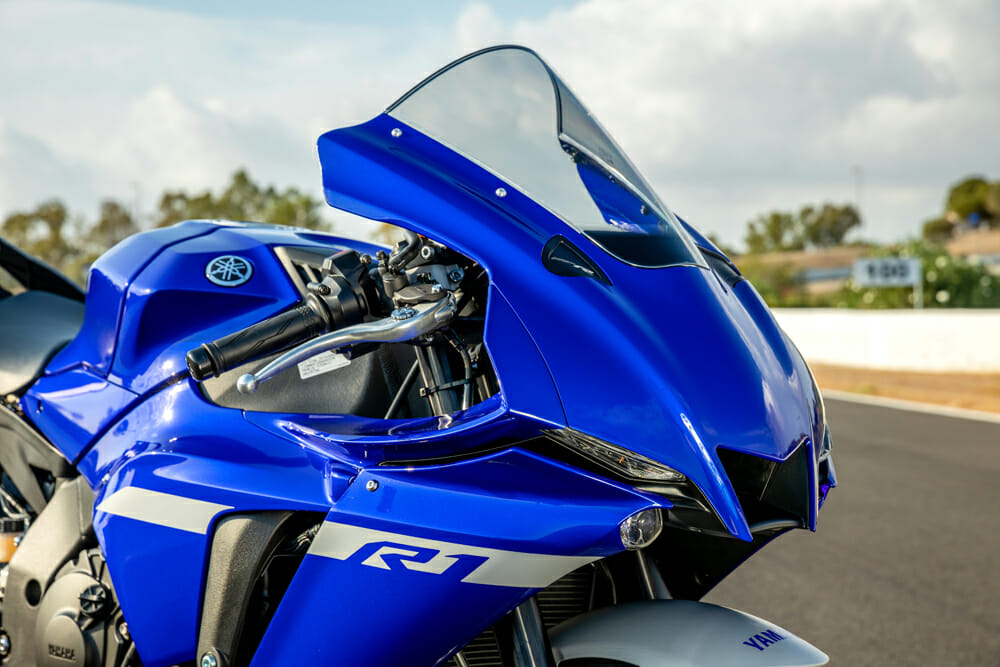 New intake looks like it’s ripped straight off the M1 of Rossi and Vinales.
New intake looks like it’s ripped straight off the M1 of Rossi and Vinales.
2020 Yamaha YZF-R1 and R1M Chassis
This is the area the R1 and R1M differ. They both share the same Yamaha Deltabox aluminum frame, aluminum fuel tank, magnesium subframe and wheels (new for the base model), but the base model comes with conventionally adjustable KYB forks and shock compared to the latest generation electric Ohlins on the R1M.
The base model R1 gets slightly softer fork springs than previous (18.12 N/mm to 18 N/mm), a new piston and shim stack layout closer to the base of the fork and new damping settings, while the shock gets new damping settings and a touch more preload of 0.5mm for the base setting.
The R1M gets the new Ӧhlins NPX pressurized chamber fork and ERS shock (the first production machine to do so), both fully adjustable via the interface on the dash. Like the base model R1, the R1M’s spring rate has been reduced, although it’s still heavier than the standard R1 with the new settings at 20 Nm compared to 21 Nm last year. The shock also gets new internal valve settings, and preload increased by 4mm for the base setting.
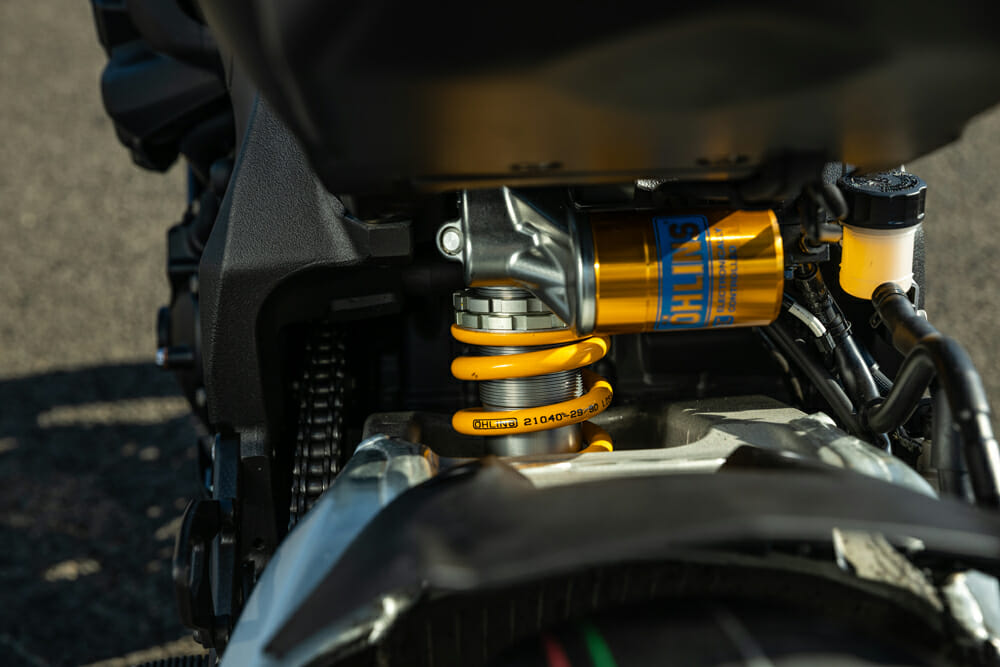 This is the first production machine to get the Ӧhlins ERS shock.
This is the first production machine to get the Ӧhlins ERS shock.
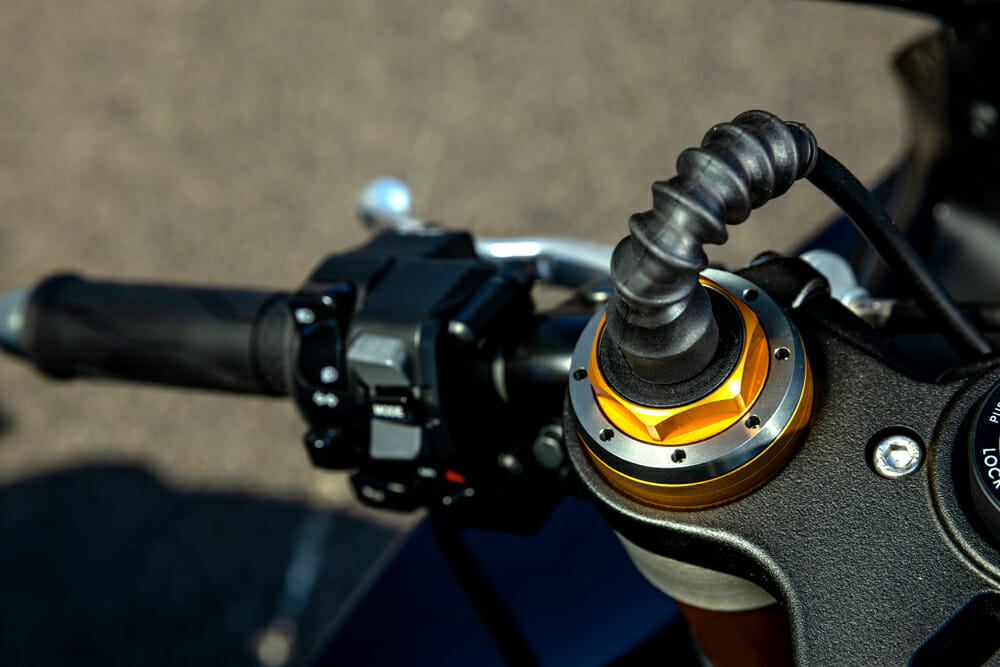 The R1M gets the new Ӧhlins NPX pressurized chamber fork.
The R1M gets the new Ӧhlins NPX pressurized chamber fork.
Importantly, the gas pressure in the fork has been reduced to stop cavitation (the little air bubbles that form after repeated use). This helps maintain more consistent damping and better feedback to the rider.
The semi-active system works in conjunction with a new algorithm that uses input from the ECU’s various components including the six-axis Inertial Measurement Unit (Yamaha was the first to bring this to production back in 2015), brake pressure, throttle position, power modes and traction and wheelie control to adjust the suspension in real time. Alternatively, you can switch the system to manual mode, which has its own set of preset or manually-entered modes for suspension performance.
The brakes get a smaller ABS pump (see electronics), new pads and the linked braking system has been removed, so now when you hit the front brakes, you won’t engage the rear. You must do that manually now.
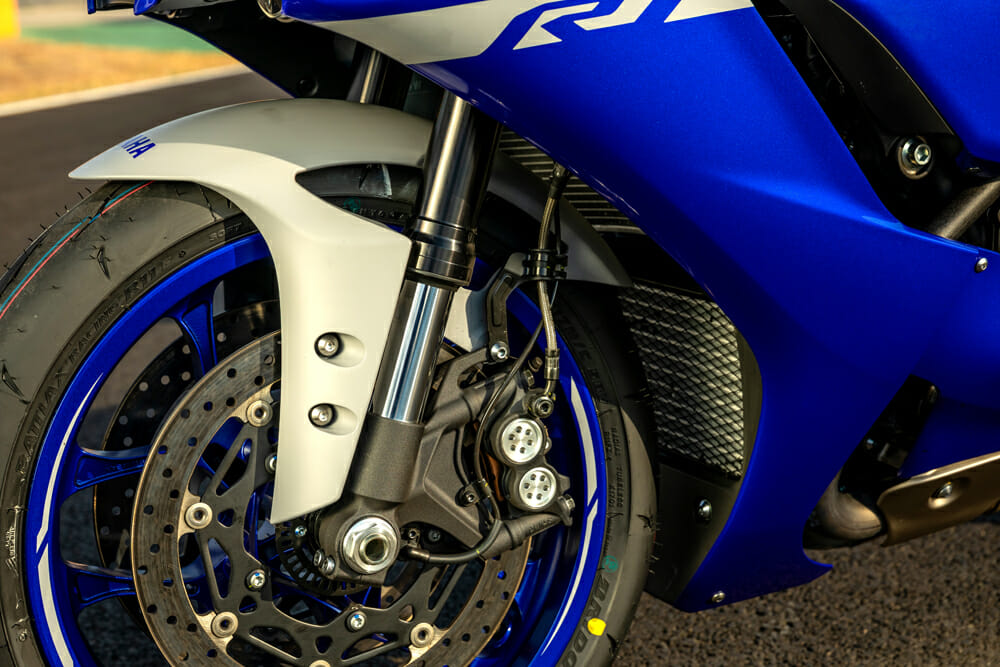 Brake performance leaves a little to be desired, according to Moreda.
Brake performance leaves a little to be desired, according to Moreda.
2020 Yamaha YZF-R1 and R1M Electronics
The base model R1 gets the same six-axis IMU, 10-stage lean-angle sensitive traction control, four-stage slide control, four-stage, recalibrated wheelie control, three-stage launch control, up and down quick shifter with three different sensitivities, four different power modes and TFT instrument panel as the R1M, but the higher-spec version gets the electronic Ohlins and beautiful carbon-fiber bodywork to justify the price.
First off, the throttle no longer has cables. Yamaha has used its Chip Controlled Throttle (YCC-T) since the 2006 Yamaha YZF-R6, but until now there’s always been a cable between you and the throttle body.
The new R1/R1M’s throttle is controlled by a magnetic sensor that sends a signal to the throttle valve motor, with Yamaha claiming the result as being a smoother, lighter operation at the grip, which helps reduce rider fatigue.
Other changes of note for both bikes is the new Engine Brake Management (EBM) software that gives the same engine braking in level one as last year, but less engine braking in levels two and three than before.
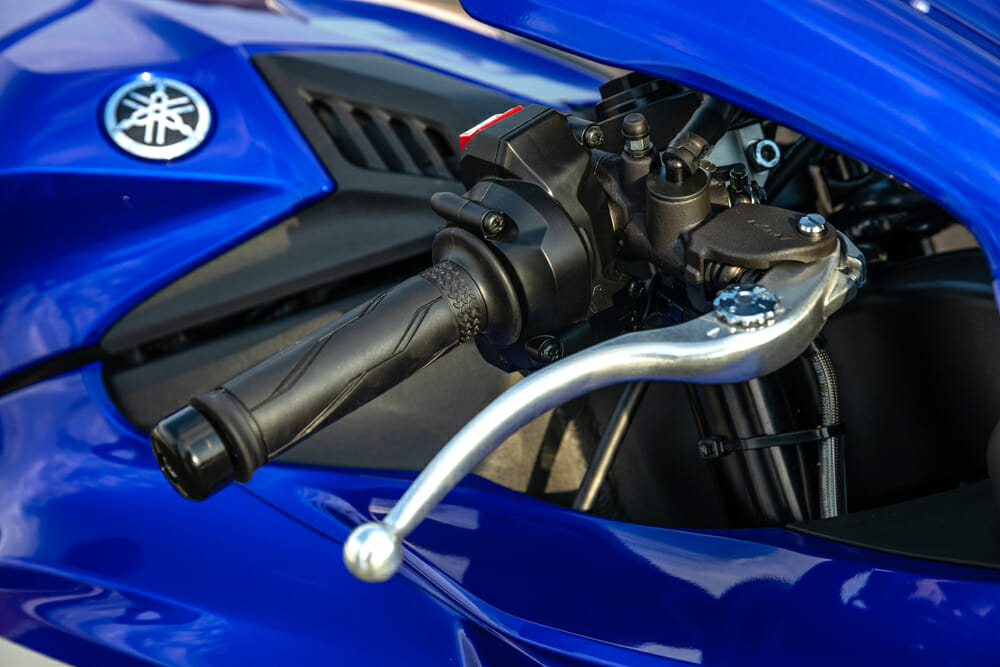 The new cable-less throttle is actuated by magnets and is much lighter to twist.
The new cable-less throttle is actuated by magnets and is much lighter to twist.
The brakes also get something different for 2020. Now that Euro 5 is upon us, manufacturers must have ABS that you cannot switch off, and this year Yamaha has introduced the Brake Control (BC) System. It gives the rider two options—BC1 or BC2—with the latter’s ABS intervention happening much earlier than the more track-orientated BC1. Again, this system works with the IMU to determine the level of intervention required.
Pretty much everything on the YZF-R1M can be adjusted via your phone on the Y-TRAC communication unit, which records data from the IMU, ECU and GPS sensors to give you an exact readout as to what you’re doing—and how fast you’re going—on track. The Y-TRAC app lets you check out things like throttle position, speed, lean angle, rpm, traction/wheelie control and slide control intervention for a given section of track, meaning there’s no way to hide when you thought you were getting hard on the gas when in truth, your buddy did it faster.
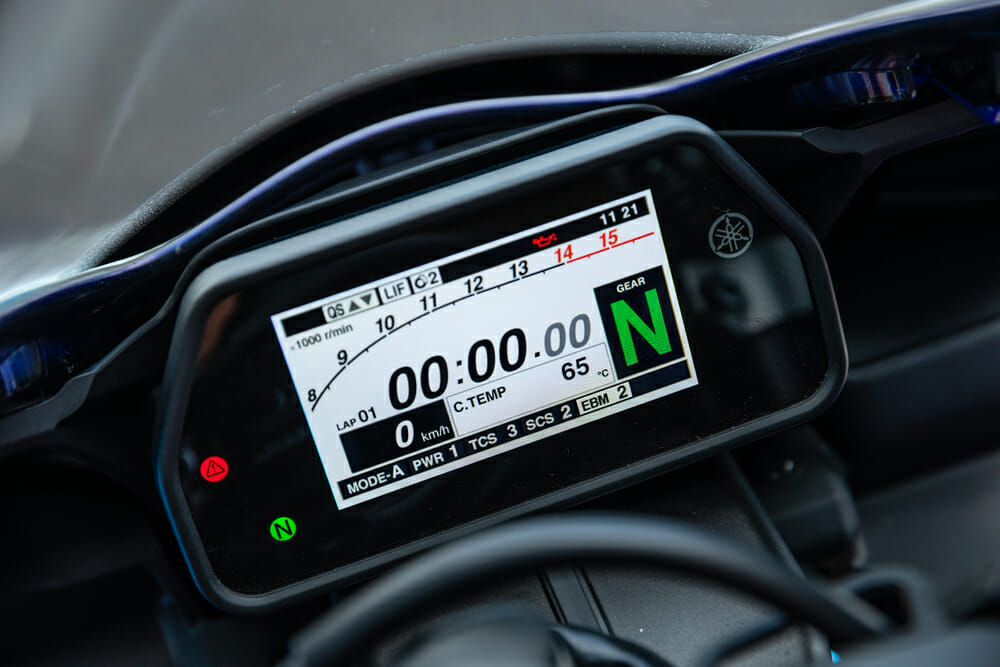 The dash is the same as in 2019.
The dash is the same as in 2019.
2020 Yamaha YZF-R1
When Rennie asked me if I’d be interested in filling in for him on the Yamaha R1 and R1-M launch, riding the two bikes at the world-class Circuito de Jerez, I had to pinch myself.
Being one of the first people in the world to put Yamaha’s new literbikes to the test on one of the world’s best racetracks is an unrivaled experience that I am honored to be a part of.
I was excited to try these bikes in comparison to my current racebike, a 2015 Yamaha R1 that I race in the Stock 1000 class at MotoAmerica as well as in the AFM.
Learning a bike and a track together is sometimes challenging, but the new YZF-R1 made it easy. It was confidence-inspiring, and I could feel the electronics working in my favor when I’d push my limits.
There were a lot of things that were very different from my 2015 R1 racebike, most notably the electronics and the ride-by-wire throttle. I felt like the new R1’s electronics were much smoother than my racebike, especially the wheelie control.
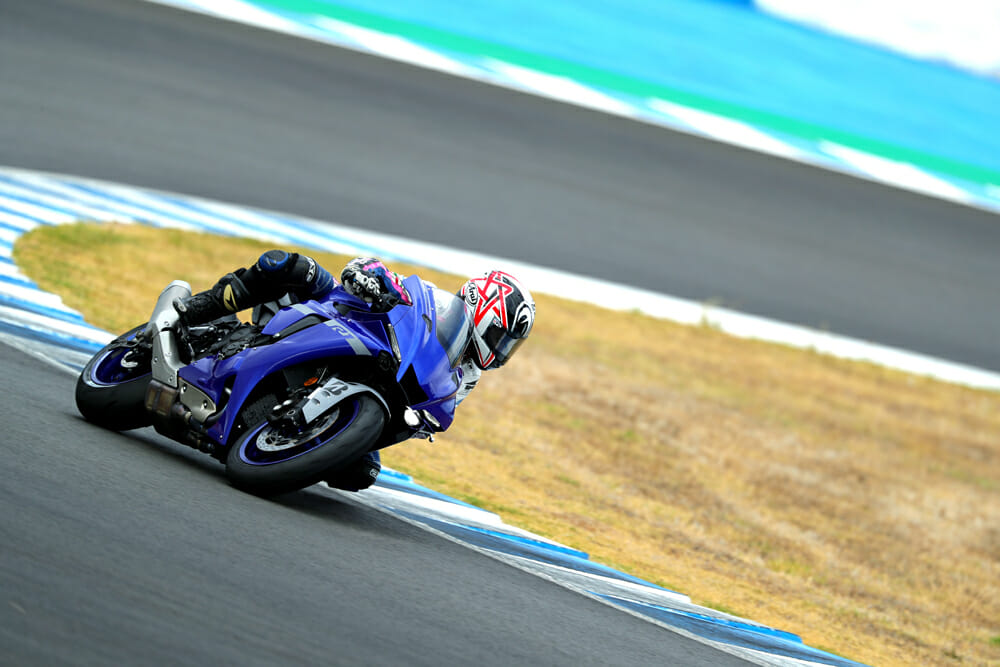 The base model R1 is an excellent steed and would provide a good basis for a racer given you’ll probably not go for the electronic suspension anyway if you intend to front the start.
The base model R1 is an excellent steed and would provide a good basis for a racer given you’ll probably not go for the electronic suspension anyway if you intend to front the start.
This new model’s wheelie control is very non-invasive. You can barely feel the bike cutting out to bring the wheelie back down, whereas my racebike is a bit harsh in that department. It makes me want to go mess with my electronics immediately! The traction control on the 2020 R1 was similar in that where I could feel it working, but it really didn’t slow me down.
I’d had a conversation with Aaron Bast and Marcus DeMichele from Yamaha USA about the throttle, how I like one that is light and easy to turn, and also how I like a quick-turn throttle for racing (those two things do not usually go hand in hand).
As it is, the magnetic sensor throttle is much easier to turn than on the 2018 R1, but it’s somehow smoother and is definitely one of the bike’s strong points.
The front brakes and Bridgestone RS11 tires on the base model YZF-R1 left something to be desired. The brakes didn’t have as much bite as I would like, though I didn’t experience brake fade, so they were at least predictable in their performance.
For me, I would throw on a set of my Vesrah race pads and racing braided lines before getting serious on the track. The stock tires should prove to be fine for the street, but in the track environment, this bike is built for slicks—or at least DOT race tires.
There are a couple things that won’t affect most people riding this bike, but as a smaller rider, I’d like to see more adjustability in the brake lever and the shifter. My boots are size 7.5 women’s, and my toes barely reach the shifter, which doesn’t translate to clean shifts every time. I was lucky the Pata Yamaha World Superbike Team had an adjustable brake lever available, as it had more adjustability and helped me be more comfortable on the bike.
If the new R1 or R1M were my bike, the lever and shifter (or rearsets) would be first on my change list.
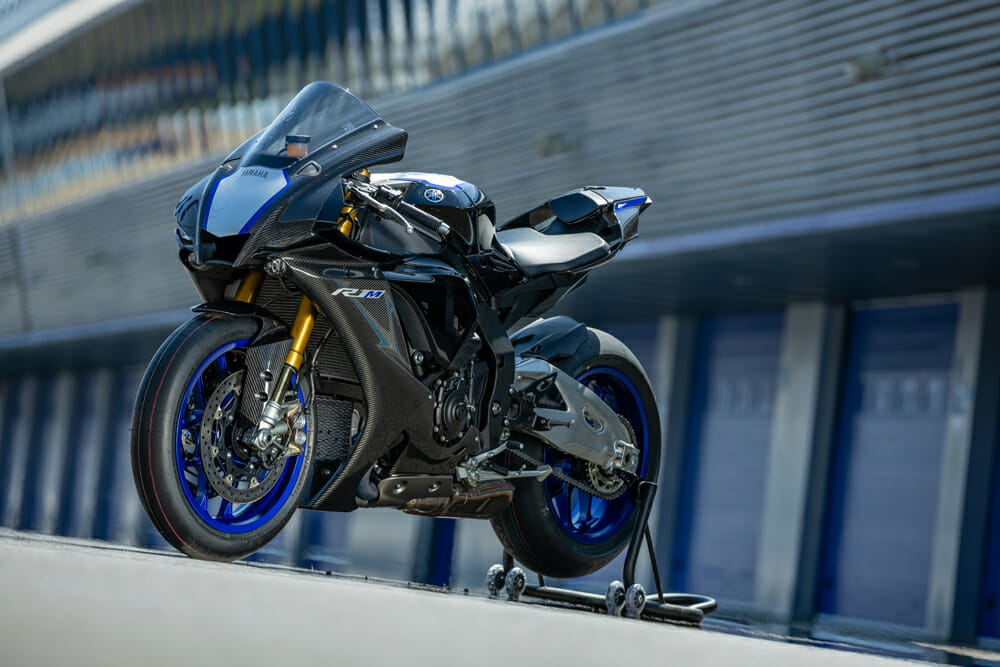 Stunning, right? The R1M is undoubtedly a head-turner.
Stunning, right? The R1M is undoubtedly a head-turner.
2020 Yamaha YZF-R1M
I had fun riding the base model R1, and while I was impressed with it, after lunch, I got on the YZF-R1M. Within three corners, I could tell this was a real weapon of a machine.
The YZF-R1M is a much more purpose-built bike. It feels like a racebike.
When I got on the brakes hard, I immediately felt that it had more stopping power, and when it got a little loose on the brakes, it still felt extraordinarily controllable and confidence-inspiring. The R1M settled into the corners better than the standard model, the suspension action was far superior to the YZF-R1, and the slick Bridgestone tires fitted to the test bike just topped the whole package off.
When I got off the track after the first session, I was beaming, giving high-fives to the Japanese development team who were there for the launch, and giving big thumbs up to the test riders, Kazuyuki Nishimura (chassis & suspension development test rider) and Tomoya Osaka, who is the engine & electronics development test rider. This bike is brilliant.
Yamaha has made it so that even a suspension newbie can fine-tune this bike for their own riding style. They’ve started with an excellent baseline, then added all the adjustability most people could wish for so that you can start with a great package, and dial it in, and change it according to your wants on a different day, or at a different track.
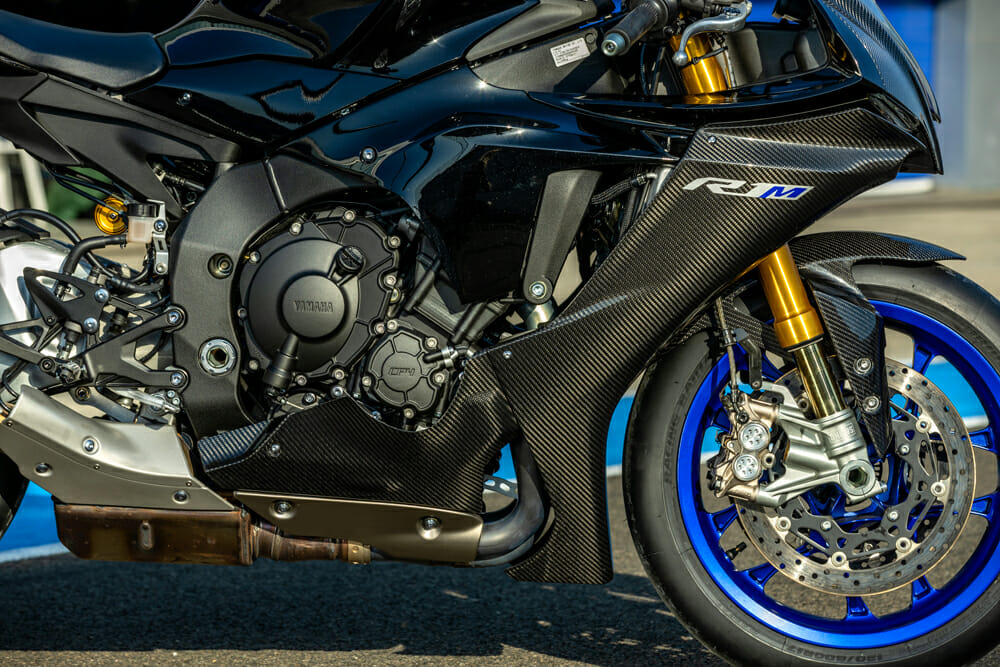 The carbon fiber gives the R1M an alluring character, however, for the price, it would be nice to see the bike come with adjustable rearsets.
The carbon fiber gives the R1M an alluring character, however, for the price, it would be nice to see the bike come with adjustable rearsets.
I was shown how to easily adjust the bike to be stiffer while I was braking, or to make it squat less when I was on the throttle. It’s got sensors in the bike that know when you’re on the gas, in a turn, on the brakes a little or a lot, and it uses the information from these sensors to adjust your suspension on the fly.
Your suspension tuner is your dash, so you don’t have to learn about compression and rebound and all of that confusing stuff (if you don’t want to). And while you can still adjust each and every one of those things, you can also do a whole lot of good for your riding by merely playing around with the dials on the dash or the touch of your tablet!
The top-of-the-line electronics extends to the rest of the bike, with the engine braking and wheelie control and lots of trick components adjustable on the fly.
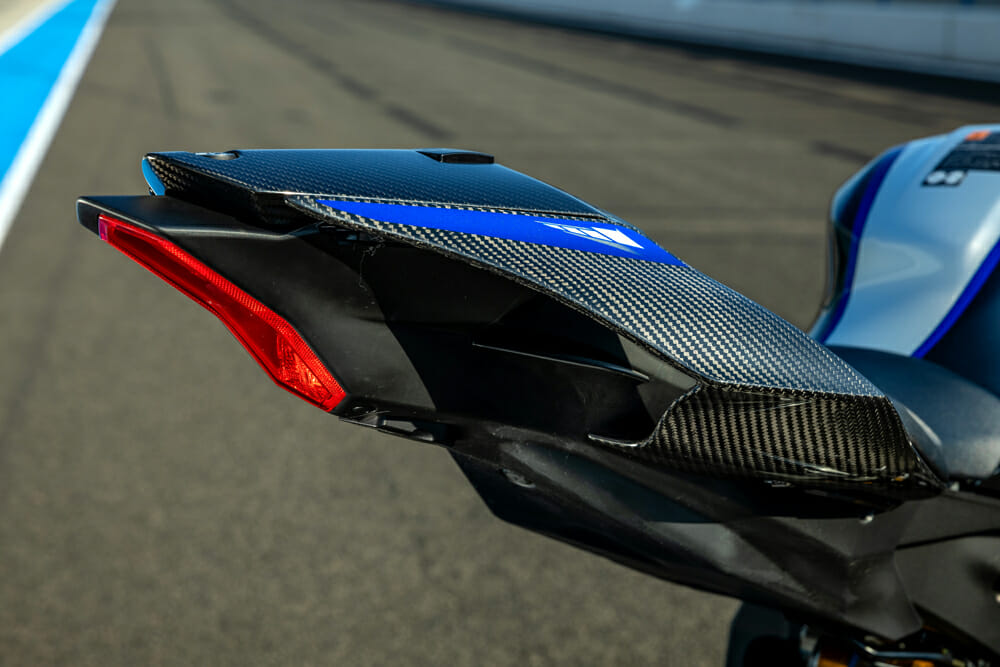 Still one of the best-looking rear ends in the business.
Still one of the best-looking rear ends in the business.
A couple other cool things about this new YZF-R1M are all the little details in the styling. The fairings are tapered off instead of having sharp lines, which I wasn’t sure about until I heard Josh Hayes talk about it.
The four-time MotoAmerica Superbike Champion said it allowed him to have his body position how he wanted and didn’t negatively affect his legs. I also loved all the carbon fiber on the R1M, though photos don’t ever seem to do carbon fiber justice.
The new intake also caught my attention because I’m so used to seeing plastic intakes, that the idea of an aluminum one never dawned on me. The plastic one has just enough give, though, that it allowed the nose of the bike to dive, ever so slightly, under wind pressure at high speeds, and Hayes commented that he could actually see that happen. Now it’s aluminum and will hold the nose up more sturdily. Yamaha’s not gone too overboard with the changes for the YZF-R1 and YZF-R1M. What they have done has amounted to a better bike than what was on sale this year. It’s also future-proofed the bike somewhat, so it’s unlikely we’ll see any more changes to the bike for at least another couple of years.
That’s all well and good because as Cameron Beaubier has just proved, the R1 is still at the very forefront of superbike racing and technology.—Shelina Moreda
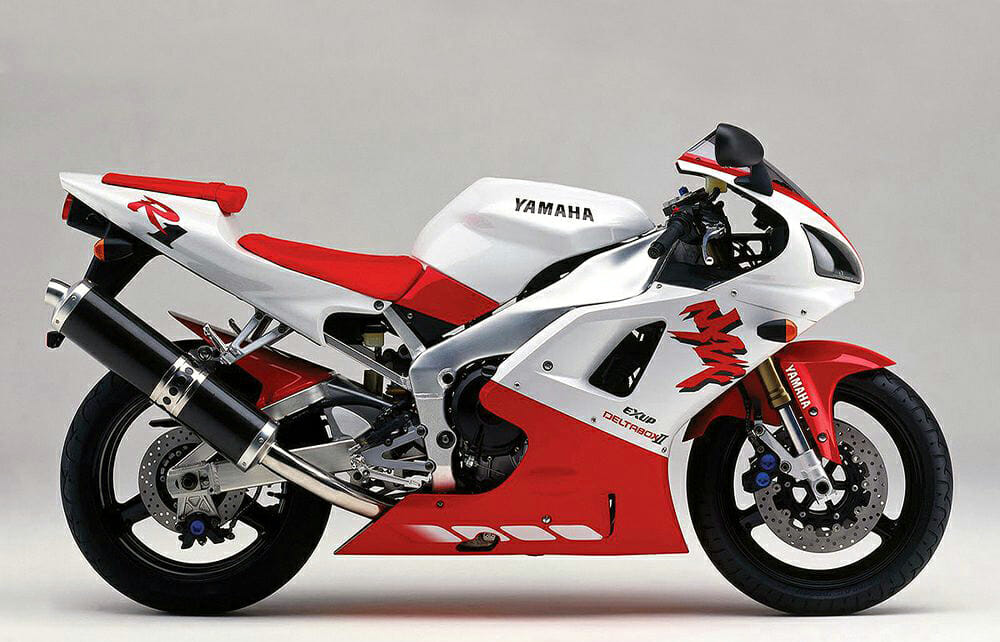
The OG
Twenty-two years on, we look at the bike that started it all
The 1998 Yamaha YZF-R1 is a true benchmark motorcycle. We knew this immediately on its release, just like we did the Honda RC30, the Kawasaki Z1 900 and the Honda CB750 before that.
That red-and-white missile is burned into motorcycling’s collective subconscious and was the baby of Kunihiko Miwa who wanted to create the ultimate “no-compromise” road motorcycle.
Miwa-san’s most significant and most long-lasting advancement when creating the first YZF-R1 was to mount the gearbox output shaft above the crankshaft, rather than in a line as per common wisdom. This created the world’s first “vertically-stacked gearbox,” ensuring an ultra-compact and lightweight engine and setting the blueprint for all other engineers to follow.
The offshoot of this meant the chassis and wheelbase dimensions could be reduced while using a longer swingarm to aid traction under acceleration. Miwa-san had created a monster.
The cylinder head on the first YZF-R1 was nothing flash—Miwa-san still used the five-valve head so dear to Yamaha’s heart; carbies took care of fueling as EFI was still four years away; there was no ram air and electronics? Don’t be stupid. This was before the age of traction control, anti-wheelie, ABS, and IMU. The only traction control available was in your right hand.
The 1998 Yamaha YZF-R1 simply blew the 919cc Honda CBR900RR into the past, and it’s no understatement to say this was the first superbike of the modern age. Upside-down forks, carbon muffler for the four-into-one exhaust, garish red and white paint scheme (it also came in blue, but the red and white model is the one everyone wants), plus edgy, futuristic styling that made everything else look instantly outdated—this was and still is a blisteringly brilliant motorcycle. Yamaha claimed about 148 hp and 430 pounds ready to ride for their new missile—staggering numbers in 1998.
The game wasn’t just changed. It was reinvented.—Rennie Scaysbrook
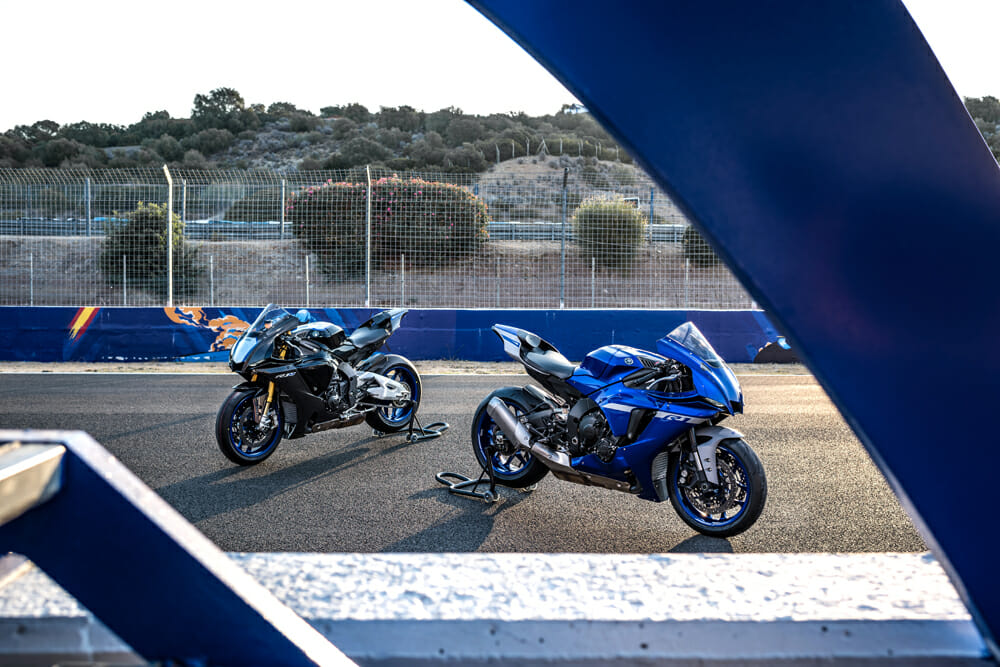
2020 Yamaha YZF-R1/YZF-R1M Specifications
| MSRP: |
$17,399 YZF-R1/$26,099 |
| Engine: |
Liquid-cooled inline 4-cylinder DOHC; 16 valves |
| Displacement: |
998cc |
| Bore x stroke: |
79 x 50.9mm |
| Compression ratio: |
13.0:1 |
| Fuel delivery: |
Fuel injection with YCC-T and YCC-I |
| Transmission: |
6-speed cassette |
| Clutch: |
Wet, multi-plate, slipper |
| Chassis: |
Twin-spar aluminum |
| Front suspension: |
43mm KYB inverted fork, fully adjustable / 43mm Öhlins Electronic Racing Suspension NPX fork, fully adjustable |
| Rear suspension: |
KYB single shock, fully adjustable / Öhlins Electronic Racing Suspension single shock, fully adjustable |
| Front-wheel travel: |
4.7 in. |
| Rear-wheel travel: |
4.7 in. |
| Front brake: |
Dual 320mm hydraulic disc; Brake Control System and ABS |
| Rear brake: |
Single 220mm hydraulic disc; Brake Control System and ABS |
| Front tire: |
120/70 ZR17 in. |
| Rear tire: |
190/55 ZR17/200/55 ZR17 in. |
| Wheelbase: |
55.3 in. |
| Seat height: |
33.9 in. |
| Fuel capacity: |
4.5 gal. |
| Weight: |
448 lb. / 450 lbs. ABS |
| Colors: |
Team Yamaha Blue; Raven / Carbon Fiber |
